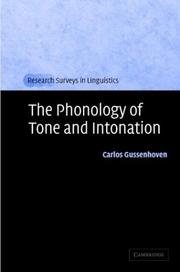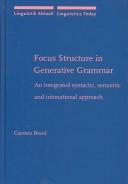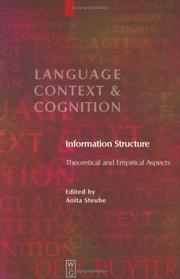| Listing 1 - 3 of 3 |
Sort by
|

ISBN: 0521812658 0521012007 9780521012003 9780521812658 9780511616983 0511214553 9780511214554 0511212747 9780511212741 0511216343 9780511216343 0511616988 9780511210976 0511210973 9786610540747 6610540748 1107144434 1280540745 0511315198 Year: 2004 Publisher: Cambridge Cambridge University press
Abstract | Keywords | Export | Availability | Bookmark
 Loading...
Loading...Choose an application
- Reference Manager
- EndNote
- RefWorks (Direct export to RefWorks)
Tone and Intonation are two types of pitch variation, which are used by speakers of all languages in order to give shape to utterances. More specifically, tone encodes segments and morphemes, and intonation gives utterances a further discoursal meaning that is independent of the meanings of the words themselves. In this comprehensive survey, Carlos Gussenhoven provides an overview of research into tone and intonation, discussing why speakers vary their pitch, what pitch variations mean, and how they are integrated into our grammars. He also explains why intonation in part appears to be universally understood, while at other times it is language-specific and can lead to misunderstandings. After eight chapters on general topics relating to pitch modulation, the book's central arguments are illustrated with comprehensive phonological descriptions - partly in Optimality Theory - of the tonal and intonational systems of six languages, including Japanese, Dutch, and English.
Tone (Phonetics) --- Intonation (Phonetics) --- Grammar, Comparative and general --- Phonology --- 801.4 --- Fonetiek. Fonologie --- Phonology. --- 801.4 Fonetiek. Fonologie --- Intonation (Phonetics). --- Tone (Phonetics). --- Language and languages --- Lexical tone (Phonetics) --- Tone languages --- Tonology (Phonetics) --- Phonemics --- Phonetics --- Linguistics --- Pitch (Phonetics) --- Prosodic analysis (Linguistics) --- Oral interpretation --- Tone --- Intonation --- Arts and Humanities --- Language & Linguistics --- Philology --- Grammar, Comparative and general - Phonology --- Grammar, Comparative and general Phonology --- TON (PHONETIQUE) --- INTONATION (PHONETIQUE) --- GRAMMAIRE COMPAREE ET GENERALE --- PHONOLOGIE

ISBN: 1423766393 9786612254451 9027295603 1282254456 9781423766391 9027227926 9789027227928 1588115038 9781588115034 Year: 2004 Publisher: Amsterdam Philadelphia John Benjamins Pub.
Abstract | Keywords | Export | Availability | Bookmark
 Loading...
Loading...Choose an application
- Reference Manager
- EndNote
- RefWorks (Direct export to RefWorks)
The notion of focus structure in this work refers to the distinction between categorical, thetic and identificational sentences. The central claim is that the syntactic representation of every sentence has to encode which of these types of focus structure is realized. This claim is discussed in great detail with respect to syntax, intonation and semantics within the framework of the Minimalist Program. It is shown that the incorporation of focus structure into syntax offers new perspectives for a solution of vexing problems in syntax and semantics. For example, fronting (preposing, 'topicalisation') is treated as a syntactic operation which clearly belongs to core grammar, i.e. is not optional or 'stylistic'; the semantic notion of quantifier raising is dispensed with in favour of a focus structural treatment of phenomena which gave rise to it. The book appeals to generative linguists and to functional linguists who do not believe in an unbridgeable gap between the formal and functional analysis of language.
Focus (Linguistics) --- Generative grammar. --- Grammar, Comparative and general --- Semantics. --- Intonation (Phonetics) --- Language and languages --- Linguistics --- Pitch (Phonetics) --- Phonetics --- Prosodic analysis (Linguistics) --- Tone (Phonetics) --- Oral interpretation --- Formal semantics --- Semasiology --- Semiology (Semantics) --- Comparative linguistics --- Information theory --- Lexicology --- Meaning (Psychology) --- Syntax --- Grammar, Generative --- Grammar, Transformational --- Grammar, Transformational generative --- Transformational generative grammar --- Transformational grammar --- Psycholinguistics --- Discourse analysis --- Syntax. --- Intonation --- Derivation --- Topic and comment --- Focus (Linguistics). --- Intonation (Phonetics). --- Philology --- Grammar, Comparative and general Syntax

ISBN: 3110905892 9783110905892 9783110179347 3110179342 Year: 2004 Volume: v. 1 Publisher: Berlin de Gruyter
Abstract | Keywords | Export | Availability | Bookmark
 Loading...
Loading...Choose an application
- Reference Manager
- EndNote
- RefWorks (Direct export to RefWorks)
Der Band behandelt die Schnittstelle zwischen Pragmatik, Grammatik und Psycholinguistik bzw. Neurolinguistik. Pragmatisch bedingt sind die Zurechnungen von Satzteilen zur bekannten oder zur Neuinformation im Text. Realisiert werden die pragmatischen Gliederungen aber in der Grammatik. Die theoretische Modellierung erfolgte in generativen Grammatiken, in optimalitätstheoretischen Modellen oder anhand der Alternativsemantik.Der Schwerpunkt der Untersuchung liegt auf Korrekturkonstruktionen und auf Hutkonturen. Erstere zeichnen sich durch Kontrastakzente aus und Letztere sind zweigipflig akzentuiert. Um die Prosodie weiterzuentwickeln, beschäftigt sich die Hälfte der Beiträge mit dem psycholinguistischen und neurophysiologischen Nachweis der Intonationsparameter und mit ihrer Auswertung im Kontext.Von der Kontrastintonation geht der Band dann über zur Typologie von Kontrastkonstruktionen, zu ihrem grammatischen Vergleich und ihrer textuellen Verwendung.
Contrastive linguistics. --- Focus (Linguistics) --- Grammar, Comparative and general --- Intonation (Phonetics) --- Semantics. --- Formal semantics --- Semasiology --- Semiology (Semantics) --- Comparative linguistics --- Information theory --- Language and languages --- Lexicology --- Meaning (Psychology) --- Linguistics --- Pitch (Phonetics) --- Phonetics --- Prosodic analysis (Linguistics) --- Tone (Phonetics) --- Oral interpretation --- Functional sentence perspective (Grammar) --- Predicate and subject (Grammar) --- Subject and predicate (Grammar) --- Theme and rheme --- Topic and comment (Grammar) --- Discourse analysis --- Topic and comment. --- Intonation --- Subject and predicate --- Syntax --- Topic and comment --- Contrastive linguistics --- Semantics --- 801.56 --- 801.56 Syntaxis. Semantiek --- Syntaxis. Semantiek --- Focus (Linguistics). --- Intonation (Phonetics). --- Philology
| Listing 1 - 3 of 3 |
Sort by
|

 Search
Search Feedback
Feedback About UniCat
About UniCat  Help
Help News
News